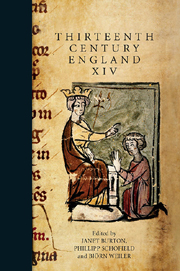Book contents
- Frontmatter
- Contents
- List of Figures and Tables
- Preface
- List of Contributors
- List of Abbreviations
- Politics and the People in Thirteenth-Century England
- Peasants, Litigation and Agency in Medieval England: the Development of Law in Manorial Courts in the late Thirteenth and Early Fourteenth Centuries
- Medieval Accounting Memoranda from Norwich Cathedral Priory
- The Seals of London's Governing Elite in the Thirteenth Century
- The Marriages of the English Earls in the Thirteenth Century: a Social Perspective
- Monks and Politics in Thirteenth-Century Wales and Catalonia
- Lope Fernández, Bishop of Morocco: His Diplomatic Role in the Planning of an Anglo-Castilian Crusade into Northern Africa
- On Kingship and Tyranny: Grosseteste's Memorandum and its Place in the Baronial Reform Movement
- St Edmund of Canterbury and Henry III in the Shadow of Thomas Becket
- Matthew Paris and the Royal Christmas: Ritualised Communication in Text and Practice
- Thomas of Lancaster in the Vita Edwardi Secundi: a Study in Disillusionment
- John and Henry III in the Anglo-Norman Prose Brut
- Genealogiae orbiculatae: Matthew Paris and the Invention of Visual Abstracts of English History
- The Genealogical Chronicles of Matthew Paris: Edition
The Marriages of the English Earls in the Thirteenth Century: a Social Perspective
Published online by Cambridge University Press: 05 May 2013
- Frontmatter
- Contents
- List of Figures and Tables
- Preface
- List of Contributors
- List of Abbreviations
- Politics and the People in Thirteenth-Century England
- Peasants, Litigation and Agency in Medieval England: the Development of Law in Manorial Courts in the late Thirteenth and Early Fourteenth Centuries
- Medieval Accounting Memoranda from Norwich Cathedral Priory
- The Seals of London's Governing Elite in the Thirteenth Century
- The Marriages of the English Earls in the Thirteenth Century: a Social Perspective
- Monks and Politics in Thirteenth-Century Wales and Catalonia
- Lope Fernández, Bishop of Morocco: His Diplomatic Role in the Planning of an Anglo-Castilian Crusade into Northern Africa
- On Kingship and Tyranny: Grosseteste's Memorandum and its Place in the Baronial Reform Movement
- St Edmund of Canterbury and Henry III in the Shadow of Thomas Becket
- Matthew Paris and the Royal Christmas: Ritualised Communication in Text and Practice
- Thomas of Lancaster in the Vita Edwardi Secundi: a Study in Disillusionment
- John and Henry III in the Anglo-Norman Prose Brut
- Genealogiae orbiculatae: Matthew Paris and the Invention of Visual Abstracts of English History
- The Genealogical Chronicles of Matthew Paris: Edition
Summary
The marriages of the English higher aristocracy in the later Middle Ages have been looked at from a variety of angles in recent years. Joel Rosenthal, for example, examined the motives of earls and barons for marrying and the quality of the personal relationship of the spouses between 1350 and 1500. Scott Waugh analysed the exercise of royal lordship by scrutinizing the marriages of wards in the thirteenth and early fourteenth centuries. A third perspective was taken by Simon Payling, who has studied closely the economics of marriages and the fate of heiresses from the thirteenth up to the sixteenth century. The present paper takes yet another approach: it focuses on the rank of the spouses of the earls and their children in the thirteenth century.
The search for spouses in thirteenth-century England was framed by a number of parameters. Canon law provided rules as to how closely bride and groom could be related. In 1215, the Fourth Lateran Council prohibited marriages within the fourth degree of kinship. In practice this was not absolutely imperative. Papal dispensations could be obtained and were readily granted for couples related in the third or fourth degrees. Marriages between close cousins, however, were the exception not the rule. Common law set further regulations. Widows and underage children of tenants-in-chief were in the king's gift. He decided on their marriages. Common law also determined the inheritance rights and thus the status of the earl's offspring.
- Type
- Chapter
- Information
- Thirteenth Century England XIVProceedings of the Aberystwyth and Lampeter Conference, 2011, pp. 61 - 86Publisher: Boydell & BrewerPrint publication year: 2013



